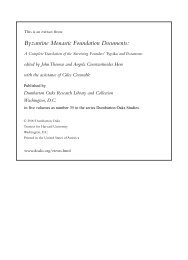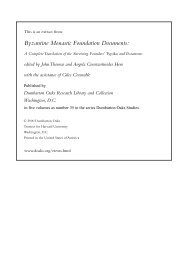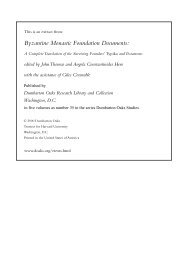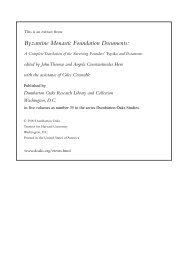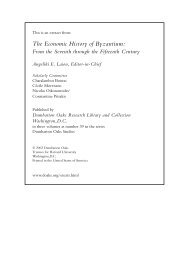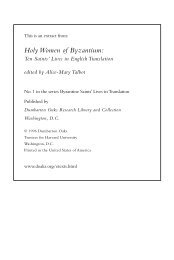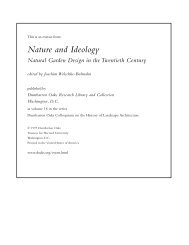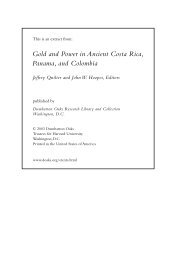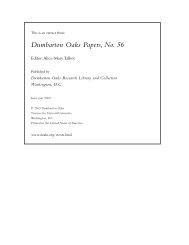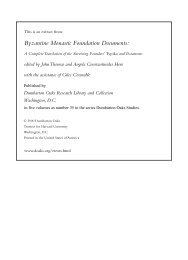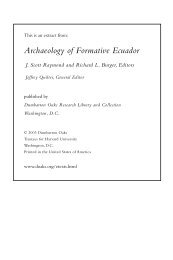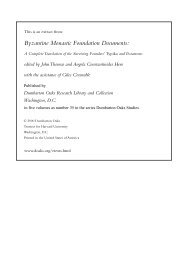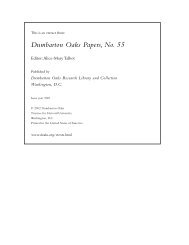Changing Economic Patterns in Latin Romania - Dumbarton Oaks
Changing Economic Patterns in Latin Romania - Dumbarton Oaks
Changing Economic Patterns in Latin Romania - Dumbarton Oaks
You also want an ePaper? Increase the reach of your titles
YUMPU automatically turns print PDFs into web optimized ePapers that Google loves.
David Jacoby [ 217 ]<br />
large landholders must have applied pressure to acquire from their own as well as from<br />
other ville<strong>in</strong>s the products they wished to market. Such a practice may have been fairly<br />
common when they had agreed to deliver specific amounts of products to a private<br />
customer or a merchant and had to meet a deadl<strong>in</strong>e. 120 A similar pattern was even more<br />
imperative <strong>in</strong> Crete with respect to wheat. From the late thirteenth century, Lat<strong>in</strong> military<br />
settlers and the powerful Cretan archontes of the Kallergis clan undertook to deliver<br />
each year specific amounts of wheat to the Commune, an obligation they had to fulfill<br />
at all cost. 121 In these circumstances, pressure on peasants appears all the more likely on<br />
the hereditary estates owned by the Kallergis, <strong>in</strong> which they had preserved and even<br />
re<strong>in</strong>forced their traditional stand<strong>in</strong>g and authority. 122<br />
The function of large landowners as middlemen <strong>in</strong> the market<strong>in</strong>g of rural produce is<br />
also documented for Frankish Greece. Large landowners did not directly engage <strong>in</strong> silk<br />
grow<strong>in</strong>g, which was exclusively carried out by peasants. Moreover, they apparently obta<strong>in</strong>ed<br />
only small amounts of silk as payment <strong>in</strong> k<strong>in</strong>d for the use of their process<strong>in</strong>g<br />
facilities by the peasants, less than 15 light pounds per village as illustrated by some cases<br />
<strong>in</strong> the 1370s which, admittedly, do not necessarily reflect an average. 123 In any event, we<br />
may safely assume that the Greek archon of Frankish Morea who <strong>in</strong> 1296 came to the<br />
fair of Vervena would not have bothered to attend it, had he not assembled a sizable<br />
quantity of silk for sale. 124 In addition to the small amounts he had collected as payment<br />
from silk growers, he must have purchased silk from his and other ville<strong>in</strong>s will<strong>in</strong>g to sell<br />
it or compelled them to do so under pressure. It is not excluded, though, that the archon<br />
also acted as middleman between other landholders of his area, who would have collected<br />
silk <strong>in</strong> a similar way, and merchants attend<strong>in</strong>g the fair. The same functions of<br />
middleman may be assumed with respect to John Laskaris Kalopheros, a Byzant<strong>in</strong>e adventurer<br />
who had wedded the daughter of Erard III Le Maure, one of the most powerful<br />
barons of Frankish Morea, and had himself become a fiefholder <strong>in</strong> the pr<strong>in</strong>cipality. In<br />
1381 Kalopheros sold <strong>in</strong> Modon 2,773 light pounds or around 950 kg of raw silk, quite<br />
a sizable amount. 125 A document of 1328 regard<strong>in</strong>g Munista <strong>in</strong> Venetian Messenia reveals<br />
that <strong>in</strong>dividual peasant households produced fairly small amounts of cocoons, between<br />
10 and 25 light pounds, which <strong>in</strong> turn yielded between ca. 2 and ca. 5 light pounds of<br />
raw silk. 126 Judg<strong>in</strong>g by these figures, the silk sold by Kalopheros would have represented<br />
the production of more than 550 peasant households. Only a few landlords of Frankish<br />
120 See Jacoby, “Cretan Cheese,” 52–53; Marcello, no. 125, a contract of 1279 specify<strong>in</strong>g that the price of<br />
cheese and wool would be determ<strong>in</strong>ed “ad eam videlicet racionem quam villani de Sythea vendider<strong>in</strong>t eorum<br />
dom<strong>in</strong>is.” The use of pressure is h<strong>in</strong>ted by the follow<strong>in</strong>g: “ita tamen quod ipsi villani vendidere non debeant<br />
dictum caseum neque lanam,” the reference be<strong>in</strong>g to free market<strong>in</strong>g by the peasants themselves. See also ibid.,<br />
no. 213, drafted <strong>in</strong> 1280: a feudatory promises to deliver his own cheese and wool as well as those of his ville<strong>in</strong>s.<br />
121 On which see below, p. 223.<br />
122 See above, p. 199.<br />
123 On such payments <strong>in</strong> Frankish Morea, <strong>in</strong> all likelihood perpetuat<strong>in</strong>g a Byzant<strong>in</strong>e practice, see Jacoby,<br />
“Silk Production,” 51–53; on amounts, see ibid., 57.<br />
124 See below, note 214.<br />
125 Jacoby, “Silk Production,” 55, 60. The light pound of Modon weighed 343 g: see ibid., 55 n. 52.<br />
126 For these and other production figures from Frankish Morea, see ibid., 57. The ratio between the weight<br />
of cocoons and silk, respectively, is around 5:1.




